Abstract
Screening for breast and ovarian cancers are required due to the late stage at diagnosis and poor survival. Serum CA125 and CA15-3 are important cancer-detecting agents in patients with ovarian and breast cancers, respectively. Elevation of CA125 and CA15-3 level correlates with malignant and non-malignant conditions. Moreover, a series of individual characteristics affect the serum level of these markers. The objective of the present study was to evaluate CA125 and CA15-3 levels in cancer-free postmenopausal women to investigate the impacts of patient parameters on the serum level of these markers. 203 subjects were studied prospectively. Serum CA125 and CA15-3 assessment was done subsequent to the direct interview. The associations between marker levels and presenting features were examined. CA125 and CA15-3 levels were elevated in 35 (17.2%) and 12 (5.9%) of persons, respectively. A higher CA125 level was associated with advanced age (p=0.046), while a lower level was correlated with hormone replacement therapy (HRT) and having smoking habits (p=0.000 andp=0.01, respectively). CA15-3 level was remarkably lower amongst oral contraceptive (OCP) users (p=0.03). Serum marker levels were not significantly related to menarche age, age at menopause, height, weight, BMI and parity. Serum CA125 is imperative indicator for malignancies of the ovary; however, personal and medical factors influence its serum level. A fair interpretation of results must be due to an accurate attention to the individual characteristics.
Similar content being viewed by others
References
Taechakraichana N, Jaisamrarn U, Panyakhamlerd K, Chaikittisilpa S, Limpaphayom KK: Climacteric: concept, consequence and care. J Med Assoc Thai 85:S1–15, 2002.
Rymer J, Morris EP: Extracts from “Clinical evidence”: Menopausal symptoms. BMJ 321: 1516–1519, 2000.
van Asselt KM, Kok HS, Putter H, Wijmenga C, Peeters PH, van der Schouw YT, Grobbee DE, te Velde ER, Mosselman S, Pearson PL: Linkage analysis of extremely discordant and concordant sibling pairs identifies quantitative trait loci influencing variation in human menopausal age. Am J Hum Genet 74: 444–453, 2004.
Jamjan L, Jerayingmongkol P: Self-image of people in their fifties. Nurs Health Sci 4:A4, 2002.
Pike MC, Pearce CL, Wu AH: Prevention of cancers of the breast, endometrium and ovary. Oncogene 23: 6379–6391, 2004.
Jacobs IJ, Menon U: Progress and challenges in screening for early detection of ovarian cancer. Mol Cell Proteomics 3: 355–366, 2004.
Crump C, McIntosh MW, Urban N, Anderson G, Karlan BY: Ovarian cancer tumor marker behavior in asymptomatic healthy women: implications for screening. Cancer Epidemiol Biomarkers Prev 9: 1107–1111, 2000.
Public Health Service. Healthy people 2010: National health promotion and disease prevention objectives — full report with commentary. Washington, DC: U.S. Department of Health and Human Services, 2000.
Maeda T, Inoue M, Koshiba S, Yabuki T, Aoki M, Nunokawa E, et al: Solution structure of the SEA domain from the murine homologue of ovarian cancer antigen CA125 (MUC16). J Biol Chem 279: 13174–13182, 2004.
Bast RC Jr: Status of tumor markers in ovarian cancer screening. J Clin Oncol 21: 200–205, 2003.
Zidan J, Hussein O, Basher W, Zohar S: Serum CA125: a tumor marker for monitoring response to treatment and follow-up in patients with non-Hodgkin’s lymphoma. Oncologist 9: 417–421, 2004.
Taylor-Papadimitriou J, Burchell JM, Plunkett T, Graham R, Correa I, Miles D, Smith M: MUC1 and the immunobiology of cancer. J Mammary Gland Biol Neoplasia 7: 209–221, 2002.
Clinton SR, Beason KL, Bryant S, Johnson JT, Jackson M, Wilson C, Holifield K, Vincent C, Hall M: A comparative study of four serological tumor markers for the detection of breast cancer. Biomed Sci Instrum 39: 408–414, 2003.
Seregni E, Botti C, Bajetta E, Ferrari L, Martinetti A, Nerini-Molteni S, Bombardieri E: Hormonal regulation of MUC1 expression. Int J Biol Markers 14: 29–35, 1999.
O’Rourke J, Mahon SM: A comprehensive look at the early detection of ovarian cancer. Clin J Oncol Nurs 7: 41–47, 2003.
Kayaba H: Tumor markers: essential diagnostic tools for radiologists. Nippon Igaku Hoshasen Gakkai Zasshi 63: 133–139, 2003.
Lu KH, Patterson AP, Wang L, Marquez RT, Atkinson EN, Baggerly KA, et al: Selection of potential markers for epithelial ovarian cancer with gene expression arrays and recursive descent partition analysis. Clin Cancer Res 10: 3291–3300, 2004.
Green BB, Taplin SH: Breast cancer screening controversies. J Am Board Fam Pract 16: 233–241, 2003.
Pauler DK, Menon U, McIntosh M, Symecko HL, Skates SJ, Jacobs IJ: Factors influencing serum CA125II levels in healthy postmenopausal women. Cancer Epidemiol Biomarkers Prev 10: 489–493, 2001.
Lopez LA, Del Villar V, Ulla M, Fernandez F, Fernandez LA, Santos I, Rabadan L, Gutierrez M: Prevalence of abnormal levels of serum tumour markers in elderly people. Age Ageing 25: 45–50, 1996.
Takami M, Sakamoto H, Ohtani K, Takami T, Satoh K: An evaluation of CA125 levels in 291 normal postmenopausal and 20 endometrial adenocarcinoma-bearing women before and after surgery. Cancer Lett 121: 69–72, 1997.
Hornstein MD, Goodman HM, Thomas PP, Knapp RC, Harlow BL: Use of a second-generation CA125 assay in gynecologic patients. Gynecol Obstet Invest 42: 196–200, 1996.
Cengiz B, Atabekoglu C, Cetinkaya E, Cengiz SD: Effect of hormone replacement therapy on serum levels of tumor markers in healthy postmenopausal women. Maturitas 46: 301–306, 2003.
Menzin AW, Kobrin S, Pollak E, Goodman DB, Rubin SC: The effect of renal function on serum levels of CA125. Gynecol Oncol 58: 375–377, 1995.
Brekelmans CT: Risk factors and risk reduction of breast and ovarian cancer. Curr Opin Obstet Gynecol 15: 63–68, 2003.
Grover S, Quinn MA, Weideman P, Koh H: Factors influencing serum CA 125 levels in normal women. Obstet Gynecol 79: 511–514, 1992.
Johnson KC, Hu J, Mao Y: Passive and active smoking and breast cancer risk in Canada. Cancer Causes Control 11: 211–221, 2000.
Author information
Authors and Affiliations
Corresponding author
Rights and permissions
About this article
Cite this article
Dehaghani, A.S., Ghiam, A.F., Hosseini, M. et al. Factors influencing serum concentration of CA125 and CA15-3 in Iranian healthy postmenopausal women. Pathol. Oncol. Res. 13, 360–364 (2007). https://doi.org/10.1007/BF02940317
Received:
Accepted:
Issue Date:
DOI: https://doi.org/10.1007/BF02940317



